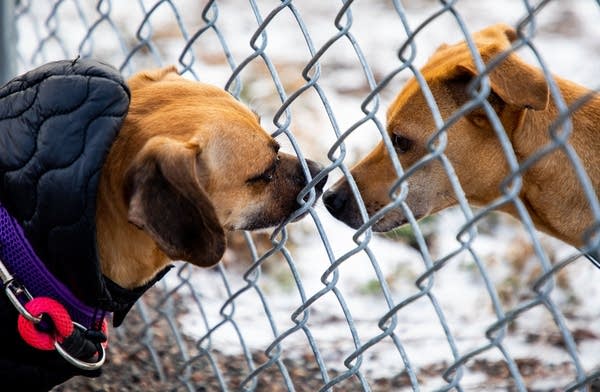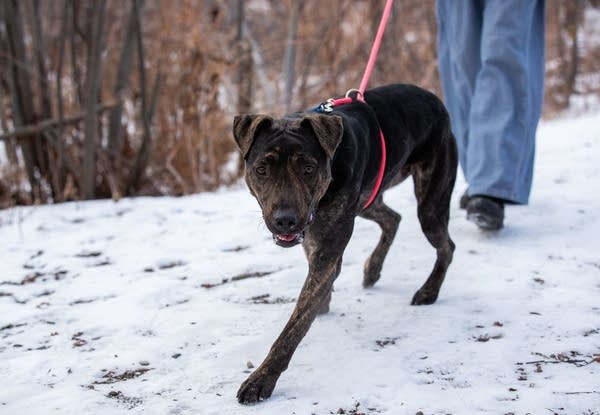Don't call them mutts. They're American Shelter Dogs

Go Deeper.
Create an account or log in to save stories.
Like this?
Thanks for liking this story! We have added it to a list of your favorite stories.
Thousands of homeless dogs turn up each year at animal shelters across Minnesota, and what happens to them there rests a lot on a single question: What breed is that?
It's what every would-be owner wants to know. For many dogs, it's a life-or-death question. But the truth is it's often quite hard to tell — enough so that a few rescue operations in the country are now embracing a new way to answer, describing their mixed-breed charges as the American Shelter Dog.
That includes Animal Allies Humane Society in Duluth, where advocates have been trying to refocus attention on what a dog does rather than what it might be. How active are they? Do they hoard toys or food? Do they get along with other dogs?"

"We spend a lot more of our time working with potential adopters to take a look at the certain and specific behaviors of each individual dog," said Lindsay Snustad, executive director of Animal Allies, the main animal shelter for a wide swath of northern Minnesota.
Turn Up Your Support
MPR News helps you turn down the noise and build shared understanding. Turn up your support for this public resource and keep trusted journalism accessible to all.
"That is the information that we celebrate, and that's the information that we stand behind," she said.
Animal Allies now identifies and advertises some of its dogs as American Shelter Dogs, animals whose salient attributes are that they are homeless and a dog.

The term was proposed nearly a decade ago by authors of a Boston study that found even dog experts had only a vague idea of what they were looking at in a mixed-breed animal, the kind that often turns up at a shelter.
The research compared eyeball-only breed estimates with genetic tests. The study found that the eye-tests mostly wrong and that even the people making the guesses agreed among themselves less than 1 in 4 times.
"It was all over the place," said Seana Dowling-Guyer, associate director at the Center for Shelter Dogs at the Cummings School of Veterinary Medicine at Tufts University, who worked on that research. "About 25 percent of the dogs were identified by the shelter by a breed that, as a match, came back from the DNA."
Researchers made up the American Shelter Dog classification hoping it would stand without preconceptions. But it can still be hard for some dogs whose adoptability and perhaps survival may lie solely in their looks. Dogs that look even vaguely like a pit bull are often written off by potential adopters as an aggressive breed.

About half the dogs that come into Animal Allies are mixed breeds, and not all of them forgo breed labels, said Snustad. "If our adoption kennel and medical leaders do all agree that a dog not only looks like a specific breed, but is exhibiting the behavioral traits of that breed, we will go ahead and label them as such."
Shifting the focus from appearances also seems to be working.
In about a year and a half since the shelter started its nonbreed specific labeling, Snustad said adoption rates have been rising. Animal Allies finds homes now for more than 100 dogs a month, on average.

Not every rescue operation embraces the American Shelter Dog.
Experts say there's been some blowback with the idea in some parts of the country, where owners have adopted American Shelter Dogs, only to have someone else suggest it was meant to obscure the true — and possibly aggressive and dangerous — nature of a dog. And it may lead to a dispute at the animal's expense.
"Breed is something that actually can give some information," said Dr. Graham Brayshaw, director of animal services for the Animal Humane Society in Golden Valley, where breed labels are still a common occurrence for dogs.
Unlike cats, which can often be classified only by the length of their coat, people have been intensely managing dog genetics for centuries, breeding the very nature of the animals, said Brayshaw.

"There are medical and behavioral issues that can be more prevalent in some breeds versus others. And some people want a more active dog, they might do better with a terrier. Where someone wants a more laid back dog, that might do better with like a big old Great Dane, that even though they're massive, they make great couch dogs, usually."
Another challenge is that Minnesota rescues often import dogs from out-of-state shelters, creating a host of legal issues like proof of vaccinations, Brayshaw said. Unless a shelter wants to re-vaccinate a dog for rabies, it has to stay tied exactly to the description it came with when it arrived in Minnesota.
Snustad, though, said descriptions do matter when it comes to animal welfare.
"This is one example of folks identifying an opportunity to get out of our own way," she said. "Stop using labels that don't necessarily align with our philosophy, and being careful about our language choices, so that we are not necessarily delaying that animal from finding a loving home."

Cherii Burke has living proof that genetics don't always equal destiny.
She was working at Animal Allies when a shipment of dogs came in from the Pine Ridge Indian Reservation in South Dakota.
She picked a puppy, Effie.
"My guess was that she was some kind of Shiba in her, because she's tan. She has the white markings of a Shiba, and as a puppy, she was on the chubbier side, like most puppies," said Burke. "Now that she's over a year, she looks more like a dingo."
Not even close. She swabbed Effie's cheek and sent in a genetic sample.
"I got back that she is a quarter lab, a quarter shepherd and an eighth Staffordshire terrier, an eighth Rottweiler and an eighth husky."
Most importantly, said Burke, "She was just this cute little (puppy), she wasn't super hyperactive. She always wanted to cuddle."
MPR News reporter Dan Kraker contributed to this report from Duluth






